Monstera Adansonii description
The Monstera Adansonii, also known as the Swiss cheese plant or five holes plant is part of the Araceae family of flowering plants. Native to Central and South America this jungle beauty is fast-growing and easy to care for. Its heart-shaped leaves and vining nature make it a crowd favorite when it comes to houseplants.
The common name for this Monstera comes from the lacey holes, called fenestrations, that develop on its leaves as they mature, resembling Swiss cheese. It loves to climb trellis or drape from a hanging basket or macrame plant hanger with plenty of indirect sunlight.
Monstera Adansonii plant facts
| common name | Swiss Cheese Plant, Five Holds Plant, Monkey Mask Plant |
| botanical name | Monstera Adansonii |
| no. of varieties | 2 |
| family | Araceae |
| biological life cycle | perennial |
| foliage | evergreen |
| mature size | typically 3–8 ft. tall (indoors) and 1–3 ft. wide |
| time to maturity | 2-4 years (grows up to 2 ft. per season) |
| origin | Central and South America |
| light conditions | bright, indirect sunlight |
| soil type | moisture-retaining, but well-draining |
| soil pH | 5.5 – 7 |
| USDA Zone | 10-11 |
| toxicity | moderately toxic to housepets, mildly toxic to humans |
Caring for monstera adansonii
Monstera Adansonii lighting 🔆
Best light: bright indirect light
Swiss cheese plants do best in a shaded environment, much like the shade they receive in the wild from upper canopy trees. Monstera adansonii leaves can burn if exposed to excessive direct sunlight. The best placement for your houseplant is in a well-lit room with bright indirect light. If you can’t avoid direct sun, make sure to limit the exposure to a maximum of 2-3hours of morning sun per day.
Monstera Adansonii watering 💧
Water requirements: 1-2 times per week during the sunny season – less in winter. Keep the soil moist.
Watering the Monstera adansonii is a delicate dance. Its roots love a moist environment but dislike soggy soil. The best way to emulate the moist soil of the jungle floor is to water once per week. To check if your houseplant needs watering, you can try sticking your finger about an inch into the soil. If the top inch of soil is starting to dry out, water your monstera until liquid starts to seep from the drainage holes at the base of the grow pot. Watch out for discoloration of the leaves, this is an indicator that your houseplant may be getting too much water.
Learn more: how often to water monstera plants
Humidity 🌫️
Jungle plants, such as the Monstera adansonii flourish in a high humidity environment. It is ideal to maintain a humidity level of 50% and above. A well-lit bathroom is a great location for your Swiss cheese plant as they typically have humid conditions. The higher the humidity level, the healthier your plant will be. To increase humidity, try misting your Monstera or using a humidifier.
Temperature 🌡️
This plant loves balmy tropical temperatures. For optimum growth keep your Monstera adansonii within a temperature range of 64 – 81 °F (18 to 27 °C). Stability is important for the Swiss cheese plant, avoid drafty rooms and areas of the house that have a furnace or space heater.
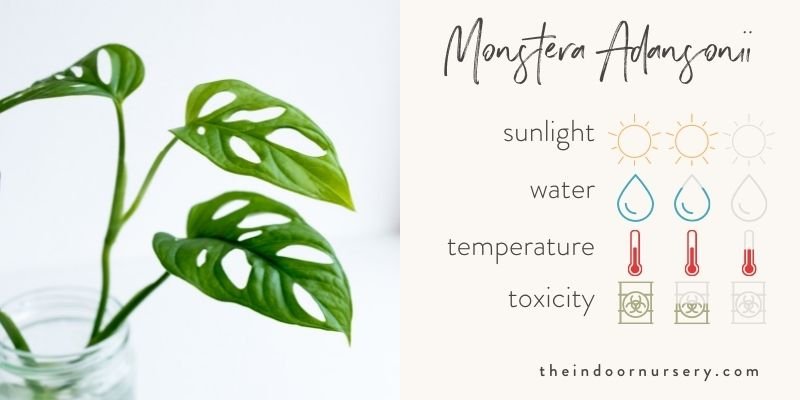
Monstera Adansonii fertilizer 💩
Fertilizer preferences: One of the things to love about this plant is how fast it grows
This is one of the reasons why using fertilizing is so important. Due to its fast-growing nature, the Monstera adansonii often cannot produce enough chlorophyll to maintain an optimum level of nutrients. Fertilizing your plant will minimize the risk of yellow leaves appearing on your beautiful vine. This is the monstera fertilizer we recommend.
It’s important to wait for 4-6months after potting or repotting your Monstera to fertilize it for the first time. This is because the potting mix typically contains a slow-release fertilizer. Following that, use an all-purpose fertilizer, diluted by half, monthly.
Monstera Adansonii soil
Soil type: moisture-retaining, but well-draining
pH level: 5.5-7
Whether in hanging baskets or growing pots your Monstera adansonii will be happiest in soil that retains moisture and is also well-draining. An easy way to trap moisture while preventing the soil from becoming waterlogged is to use a peat-based potting mix. Well-draining soil will eliminate the risk of your plant developing root rot. Here’s the best monstera soil we recommend.
Repotting
Repotting your Monstera adansonii is one of the most important aspects of the lifecycle of your plant. By repotting into a slightly larger pot each year, your plant will continue to increase in size, allowing its root system to fill out. The best time to repot is in the springtime, at the start of the growing season.
Monstera Adansonii propagation 🌱
Monstera adansonii propagation is a relatively easy process done by taking stem cuttings from the vine.
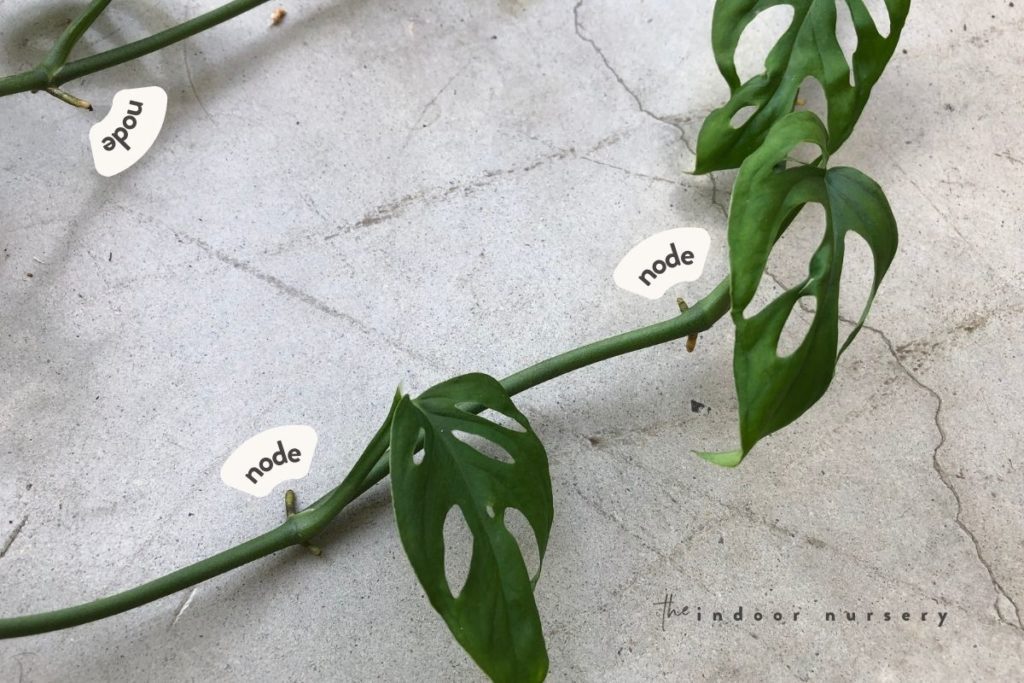
Follow these simple steps.
- After pruning your vine, select your healthiest cuttings to propagate. You’ll want to use cuttings that have at least one node and one healthy leaf. Nodes are the knobby sections just below where the leaf grows. The cut must be made below the node as that is where the roots will emerge.
- Place the cutting into a glass of water until roots start to form. The best position for the cutting is with the node submerged but the leaf above the waterline. It can take a few weeks for roots to start growing. Be sure to change the water each week.
- Once the roots are about 2 inches long, transfer your cutting into a small pot with drainage holes and a suitable potting mix, making sure the node is covered by soil without being buried too deep. Avoid fertilizing for 4-6 months.
** If you prefer to skip step 2, it is possible to plant your cutting directly into a pot, but make sure you apply a rooting hormone to the cut end to promote root growth.
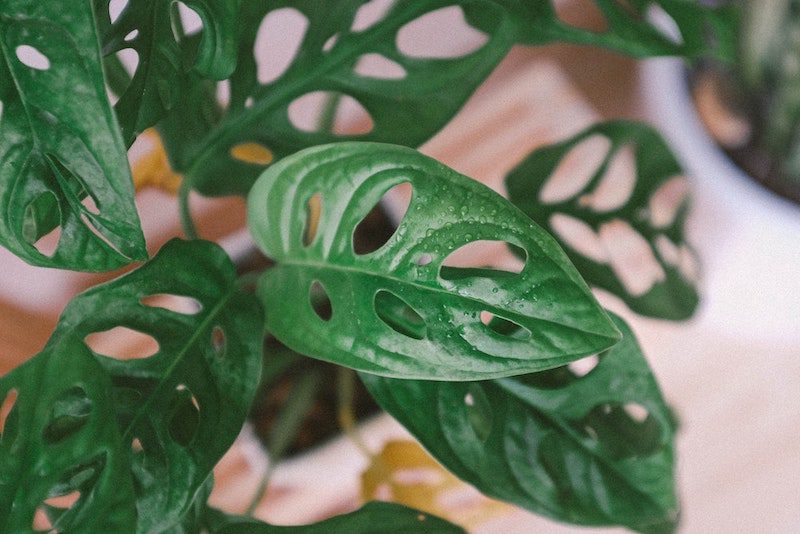
Pruning 🌿
The vines of the Swiss Cheese plant have aerial roots that enable them to climb a moss pole, trellis, or anything they can attach to. Occasional pruning will help to control and direct the growth of your vine. The best time to prune is at the beginning of Spring. You’ll need a pair of pruning shears and can start by removing any dead or damaged leaves.
Next, identify any thin stems that have few leaves on them. Pruning away the underperforming stems of the plant will allow the nutrients to reach the healthier stems, improving the overall health and growth of your vine. Make the cut just before a leaf node. If any stems are growing in an undesired direction, you can also prune back those stems, encouraging the vine to take a new direction. It’s important to note that you should limit your pruning to 25% so the plant does not go into shock. Be sure to keep your cuttings as they can be used to propagate more Monstera plants.
Pests and diseases 🐛
Pests: spider mites, aphid, thrip, scale, and mealybug
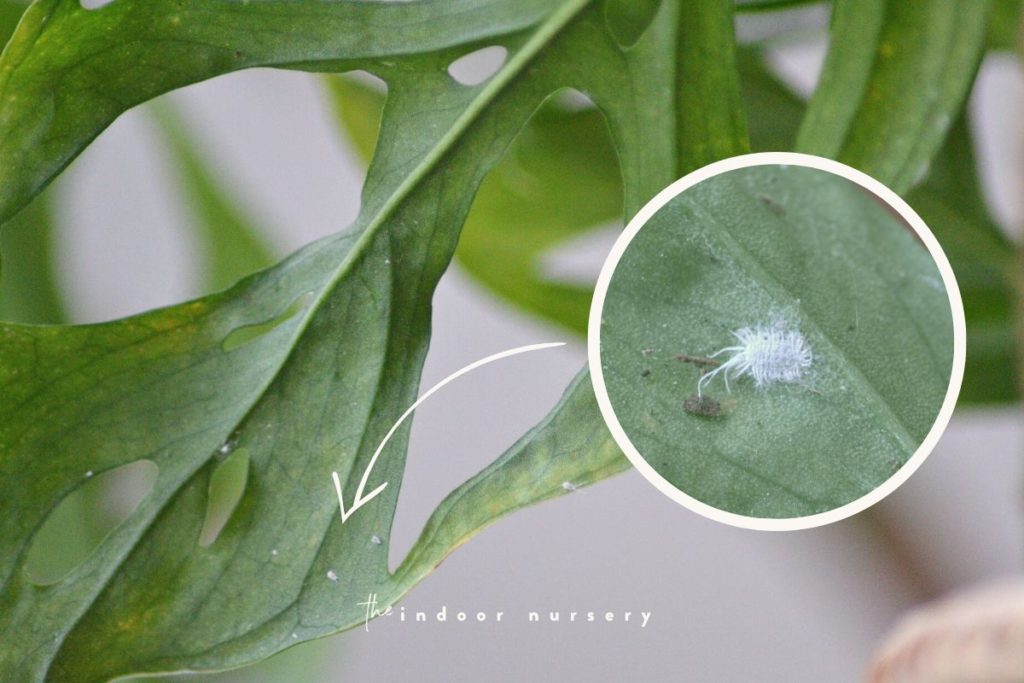
Insect species such as the spider mite, aphid, thrip, scale, and mealy bugs can be attracted to your Monstera adansonii. If you notice one of these pests on your plant, early treatment with neem oil or a non-toxic insecticide is recommended. The best way to prevent a visit from these critters is to keep your plant as healthy as possible. Weak, stressed, or undernourished plants tend to be more prone to infestation.
Monstera Adansonii care tips
- The Monstera plant species are moderately toxic to animals. Signs that your pet has come in contact with the adansonii plant are irritation of the mouth, tongue, and lips, excessive drooling, vomiting, and difficulty swallowing. Place your monstera out of your pet’s reach or in a room that your pet doesn’t access often, such as the bathroom.
- The water temperature you use makes a difference. It’s important to remember that this plant comes from Central America where the rain is warm. When watering your monstera adansonii use water that is at room temperature to mimic the jungle rain.
- Thorough watering helps to flush out salts. Water your monstera adansonii when the top inch of soil becomes dry. Give your plant enough water so that liquid flows from the holes at the bottom of the grow pot. Thorough watering imitates the tropical rain that the monstera genus has become accustomed to and flushes out salts that can build up in the soil.
Common Monstera Adansonii Questions
What is the ideal soil mix for an adansonii monstera? And is peat necessary?
You’ll want to make sure your soil mix is well-draining and can retain moisture without becoming soggy. An alternative to one that contains peat, is to combine potting mix, orchid bark, and perlite.
My Swiss Cheese plant gets yellow leaves! Please help me find out why.
A common issue for the Monstera adansonii is that they are prone to nutrient deficiency. This is because they grow faster than a lot of other plants. A sign that your plant needs more nutrients is when the leaves begin to turn yellow. Try fertilizing monthly to bring the foliage back to a lovely green.
How fast does Monstera Adansonii grow?
Monstera adansonii, like other monstera varieties, is one of the fastest-growing houseplants out there. With proper watering and light, you can expect a young plant to produce a new leaf every 1-2 months – or more, during the growing season!
More About Monsteras
- How Often To Water Monstera Plants
- Monstera Adansonii Care Guide
- Monstera Deliciosa Care: How To Care Of Monstera Plants
- Save Your Overwatered Monstera In 4 Steps (And How Not To Do It Again)
- Scale On Monstera: What To Do And How To Save It
- Best Soil For Monstera Plants (DIY Recipe + Store-Bought Options)
- Best fertilizer for Monstera plants for gorgeous leaves

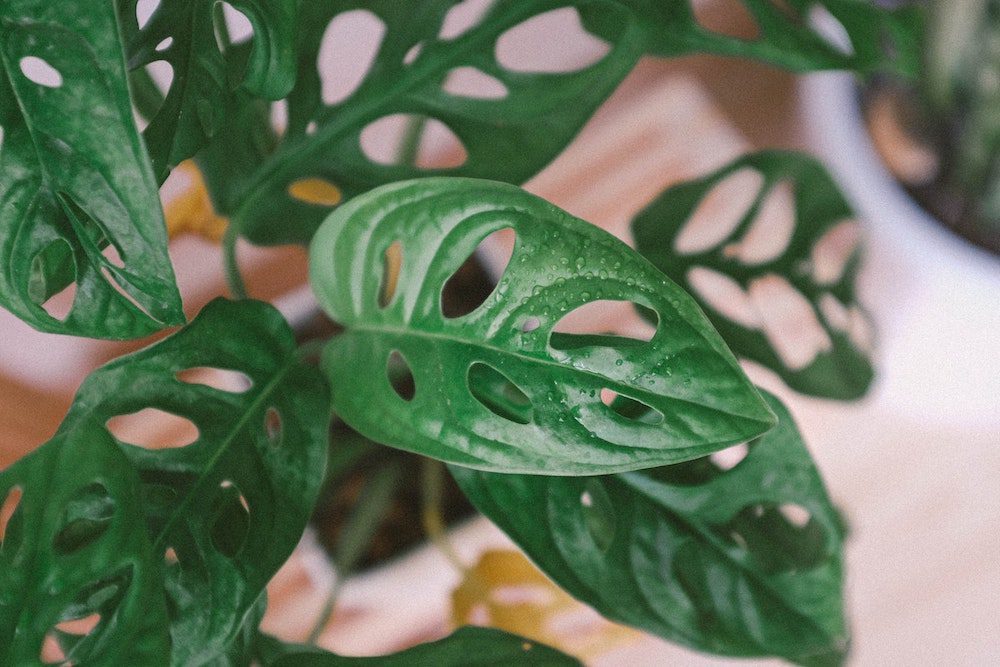
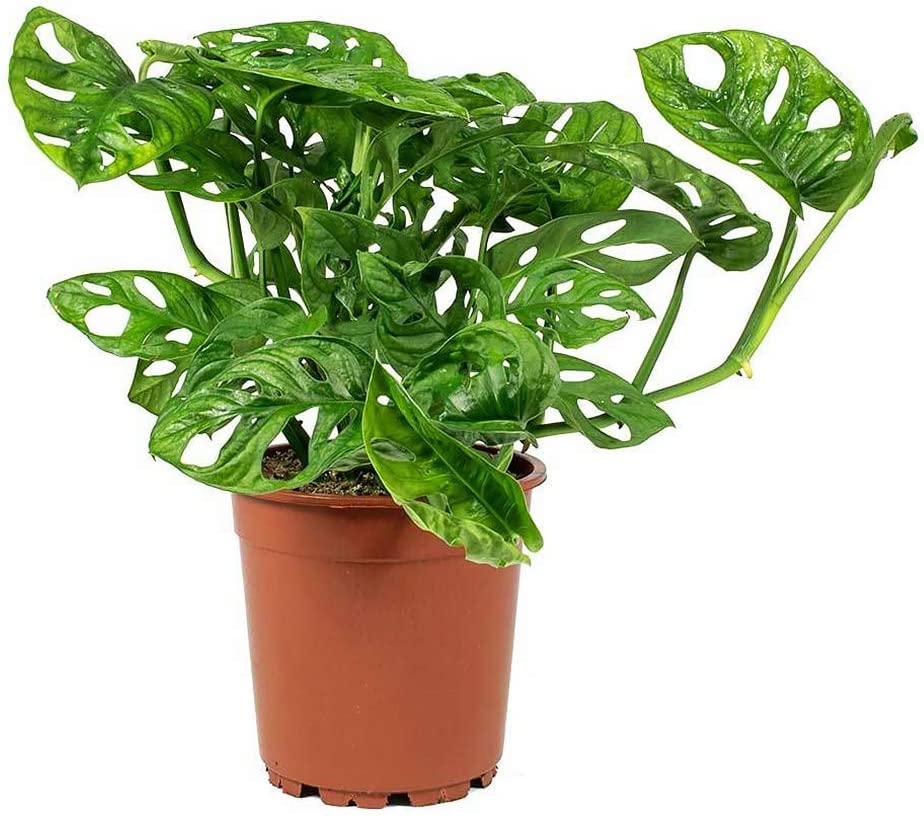





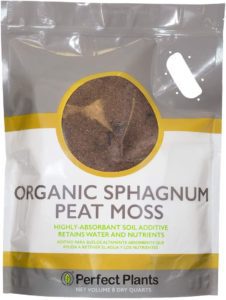
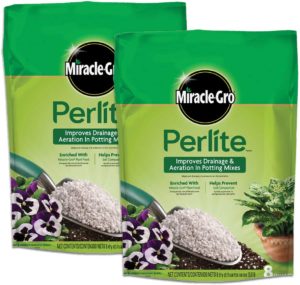



Hey, Marcia! Thanks for reading :) gosh, that's a great idea to double up on your watering globe and spike.…